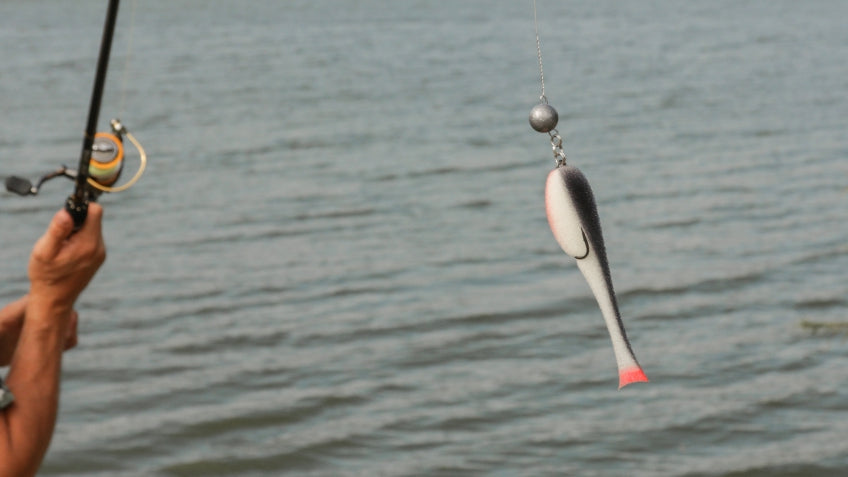Jig is often used in predator fishing in bottom waters. Colored sponge baits are considered to be popular among all kinds of artificial lures. They were invented at the end of the XX century and designed for angling. This bait is known for great fishing efficiency, a wide range of colors and reasonable price. Spong baits help to easily catch pike-perch, perch and pike and other valuable fish.

Sponge lure features
Spong baits resemble a small fish and are made of bright colored foam. Unique properties of the material make the lure attractive for predatory fish. Keep in mind that foam immediately absorbs water and becomes heavier.
Here are some advantages of sponge baits:
- Wide range of bright colors;
- Vesicular foam quickly absorbs attractants (special substances that attract predatory fish) with anise, garlic and other odors;
- Due to high flexibility of the material, the bait stays active even when soaked.;
- The bait provides easy long-distance casting (use sinker or jig head to add weight);
- The material is lightweight, so these baits won’t add much weight to the tackle box;
- The foam is wear- and water-resistant and time-proof;
- Reasonable price and simplicity. Sponge baits are much cheaper than silicone twisters, spinners, or wobblers. You can also make these lures yourself!

Types of sponge baits
There are several kinds of sponge lures:
Neon (UV). Bright-colored foam attracts predators. You can purchase baits imitating fish, or make them yourself. Foam is easy to color with waterproof paint, you can also use glitter.

Unequipped baits. This bait doesn’t have any hooks. Anglers purchase and install the hooks themselves. Due to the laser cutting method, the foam lures can imitate any shape of fish.
Single hook. This bait has a cylindrical shape and narrows near the tail. The single hook is pretty big, it is pierced through the bait and sealed up with glue. These sponge baits are distinct in small sizes and used for catching pike-perch and pike. The hook for these baits should have a rather long shank. If an angler wants to catch a small pike-perch, it’s better to use hook No.6 or 8. Before sealing up, the hook is wrapped in caprone thread, and then it can be glued.
Double hook. Some anglers also use frustum of foam cone. The double hook is inserted in the bait, both edges are on each side of the sponge bait. When a predator swallows it, the foam squeezes, allowing the hooks to strike the fish.
Treble hook. Sponge baits for treble hooks are made of wear-resistant and hard foam, using the laser cutting method. Such hooks are reliable and easily insert deep into mouth of the fish. Treble hook is made of file-hard wire. If your goal is to catch pike perch or pike, then you should buy the treble hooks with slightly bent points. With these hooks you will easily get your trophy.
Offset hook. A wide sponge bait is used for this type of lure. The point of an offset hook is inserted in the tail section. When the lure is swollen, the hook sink in predator’s mouth, your catch won’t get away. This kind of sponge lure is useful in the water bodies with heavy weeds and snags. Bear in mind that the offset hook should be installed properly for it not to be deformed.
Do colors matter?
Many people don’t know the reason why sponge baits are painted in such bright colors. The thing is that some predatory fishes are attracted to vivid shades. For instance, pike-perch, depending on a season, is attracted to purple and light-blue colors. The predator should appreciate the color in order to bite the bait. If the sponge bait doesn’t stand out, the fish will swim past it. At great depths the most contrast colors are silver and white.
Fish distinguish not only colors, but also the detailed patterns on the bait. Fish also have great visual memory. To attract a predator, you need to use contrast baits with combinations of yellow and black, red and white, and so on. The more muddy water is, the higher contrast of the bait should be.

Additional tackle of the sponge bait
You may often notice unequipped sponge baits on the market. They are basically foam fish-shaped lures without hooks, which are installed separately by anglers. The hooks, often double and treble ones, are inserted in the blank bait. Use a sharp knife to make a slot in the sponge bait and insert the hook. The shank should be directed forward, and the point of the hook should look up. The ring of the bait is forced through the head section. The slot is sealed with superglue, which is water-and wear-proof. if you use several hooks, place it one after another and join them with a music wire (it is durable and reliable). You can also burn the foam with a pre-heated awl instead of cutting a slot. The vesicular material is easily manipulated, so the tackle will be firmly inserted.
The sponge bait should have some weight. The best option is a double ear ball sinker which is connected to the bait with three split rings. The sponge bait’s action becomes more life-like. The split rings are easy to install using pliers. Nowadays, however, anglers prefer using detachable sinkers which help to achieve better results. Using them one can quickly change the bait. There are no special requirements, but the shape should be well-rounded.


Sponge bait fishing methods
Freshwater predatory fish inhabit slopes at the junction of direct and reversed river flows. There should also be a fairly deep channel pit (from 8 to 12 m) with a convenient fishing outlet with a lower depth (about 4-6 m). Here is an abundance of pike perch, catfish, and pike. A good place for fishing will also be a turn with a shoal or a whirlpool hidden under the ravine.
Here are main techniques of sponge bait fishing:
Jig retrieve. This classic effective method is accomplished by casting the bait out and letting it fall to the bottom. Then retrieve, pause and retrieve. This hopping provides the bait with a life-like action. When a predator attacks the lure, it is essential to strike.
Drag and Jig. This technique begins with casting while dropping the bait to the bottom. Then reel up two to three cranks, so the sponge bait will slowly drag raising the sand. After that, an angler quickly retrieves to lift the lure above the bottom. It is followed by a short pause, so the bait would hit the bottom again, attracting predatory fish. Pike and perch-pike are often landed using the drag-and-jig method.
Slow roll retrieve. Slow retrieve allows dragging the bait along the bottom, as if a small fish was looking for food in silt. Start twitching, pausing from time to time. The method is effective in places without heavy weeds and snags.
Sponge baits simplify fishing and ensure fine catch. You can have DIY sponge baits, but it’s better to turn attention on ready-made ones. They are properly designed, have a perfect shape and weight. We sell sponge baits with and without hooks. Each angler chooses a bait based on their preferences. Sponge baits are simple and cheap alternatives to expensive edible and inedible silicone lures. Sponge lures won’t let you down, due to their life-like action you will enjoy fishing even more. The baits will bring you valuable fish trophies.

At our shop, you can choose the sponge baits which fit you best. Find a huge choice of sponge baits of different sizes, colors, and hooks by clicking here.

